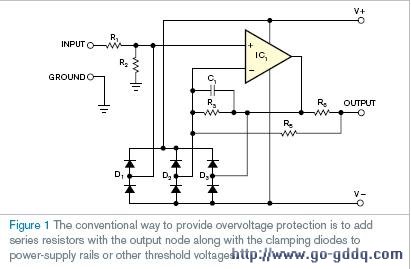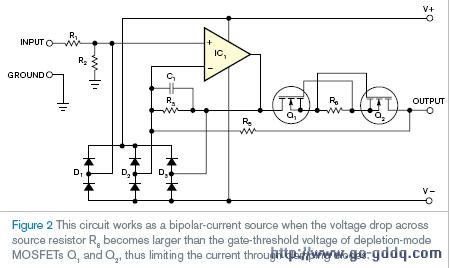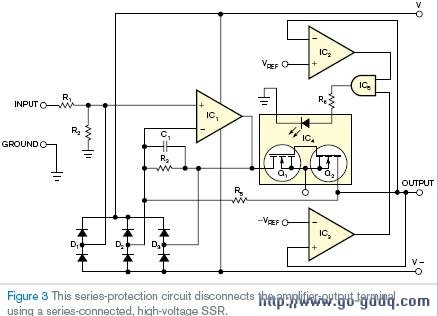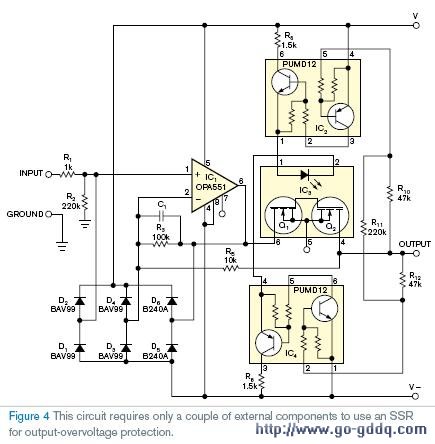为放大器输出增加晶体继电器和控制电路,提供 过电压 保护。
在测试测量应用中,必须为放大器输出终端、能量供给和类似元器件提供过电压保护。实现这个任务的传统方法是与钳位二极管一起,在输出节点到电源轨或其他门限电压之间,增加串联电阻(参考文献1和图1)。电阻显著减小了输出电流能力和电压输出随低电阻负载的波动。另一个方法是使用保险丝或其他限流设备,它们比二极管具有更高的能量吸收能力。图2中电路为双极电流源,当源电阻R6上压降增加到大于耗尽型MOSFET Q1和Q2的门限电压时,通过二极管限流(参考文献2)。这个方法的缺点是过载情况下,串联器件上能量耗散高。


输出终端出现过载电压时,合理的方法是将放大器输出节点与输出终端分离一段时间。依靠音频功率放大器中的机电继电器,有经验的工程师已使用这种串联分离,但出于不同原因:扩音器保护。 SSR (固体继电器)包括optoeleCTRonIC、photovoltaic、OptoMOS和PhotoMOS设备,由于控制和负载管脚之间的电隔离,在适度电流水平上满足负载分离任务(参考文献3)。
图3的串联保护电路,使用串联高压SSR分离放大器输出终端。输出电压增加到正参考电压限以上或降到负参考电压限以下,通过AND逻辑器件IC5,引起IC2或IC3比较器改变其输出状态,并关闭SSR IC4。图4显示实现这个方法的简单电路。


图4电路只需要一对外部器件,用SSR实现输出过电压保护。增加过电压关闭IC2中的电阻,通过IC3的控制LED中断电流流动。继电器IC3断开,保护放大器和钳位二极管。无论是否存在内部电流保护,电路用Clare、Matsushita Electronic Works和Panasonic SSR测试。供电电源采用±15V;R10、R11和R12设置触发点为±16V。省略R11偏移触发点到±14.5V。保护电路操作下,带0.5V过电压保护的SSR断开延时100到200µs,更高的过电压延时时间稍有减小。注意到,通过钳位二极管,电流峰值比带低电阻SSR更高。
英文原文:
Circuits protect outputs against overvoltage
Adding a solid-state relay and control circuitry to an amplifier's output provides overvoltage protection.
Dimitri Danyuk, Kiev, Ukraine; Edited by Charles H Small and Fran Granville -- EDN, 10/11/2007
In test-and-measurement applications, you must provide overvoltage protection for the output terminals of